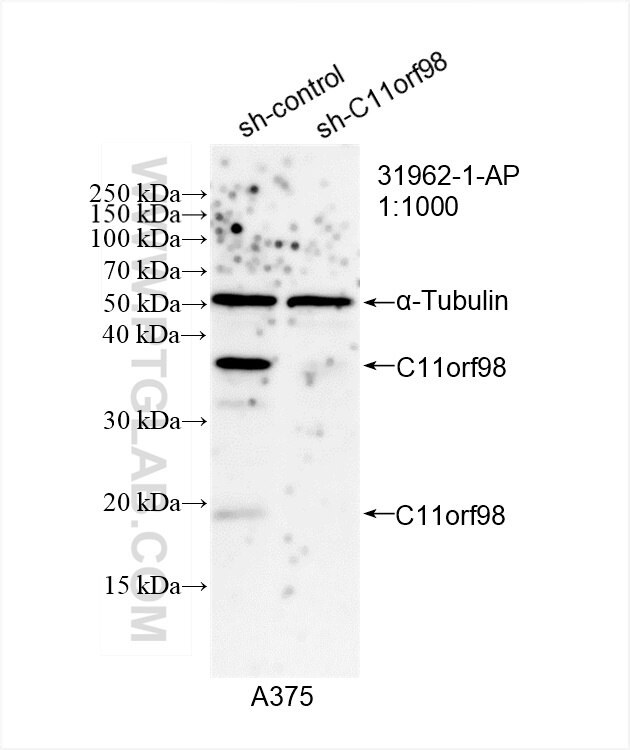Tested Applications
| Positive WB detected in | A375 cells |
Recommended dilution
| Application | Dilution |
|---|---|
| Western Blot (WB) | WB : 1:1000-1:4000 |
| It is recommended that this reagent should be titrated in each testing system to obtain optimal results. | |
| Sample-dependent, Check data in validation data gallery. | |
Product Information
31962-1-AP targets C11orf98 in WB, ELISA applications and shows reactivity with human samples.
| Tested Reactivity | human |
| Host / Isotype | Rabbit / IgG |
| Class | Polyclonal |
| Type | Antibody |
| Immunogen | C11orf98 fusion protein Ag36283 Predict reactive species |
| Full Name | chromosome 11 open reading frame 98 |
| Calculated Molecular Weight | 14 kDa |
| Observed Molecular Weight | 20 kDa |
| GenBank Accession Number | NM_001286086 |
| Gene Symbol | C11orf98 |
| Gene ID (NCBI) | 102288414 |
| RRID | AB_3670159 |
| Conjugate | Unconjugated |
| Form | Liquid |
| Purification Method | Antigen affinity Purification |
| UNIPROT ID | E9PRG8 |
| Storage Buffer | PBS with 0.02% sodium azide and 50% glycerol, pH 7.3. |
| Storage Conditions | Store at -20°C. Stable for one year after shipment. Aliquoting is unnecessary for -20oC storage. 20ul sizes contain 0.1% BSA. |
Background Information
Chromosome 11 open reading frame 98 (C11orf98, also known as C11orf48) is involved in the regulation of DNA binding transcription factor activity that stems from the spectrum of its protein partners (ESR1, ESR2, FOXA1, JUN, and WWP2) (PMID: 37373333). It can also be a putative interaction partner of nucleophosmin (NPM1) and nucleolin (NCL) (PMID: 28589727).
Protocols
| Product Specific Protocols | |
|---|---|
| WB protocol for C11orf98 antibody 31962-1-AP | Download protocol |
| Standard Protocols | |
|---|---|
| Click here to view our Standard Protocols |





